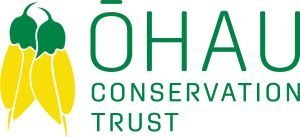 Native heath |  Turpentine shrub |  Gentian |
 Kowhai |  Muehlenbeckia |  Matagouri |
 Native Geranium |  Mistletoe |  Snow tussock |
The Ōhau Basin
The Trust’s scope of interest covers the public land within the Ōhau Basin, an area upstream of a line from the top of Ben Ōhau around to the Lake Ōhau outlet, across to the Wairepo Stream and west to the Quailburn saddle. This includes the catchments of all the direct tributaries of Lake Ōhau, enabling a ‘whole of catchment’ consideration of biodiversity values and related conservation issues. Most of the public land is public conservation land administered by the Department of Conservation, with some areas administered by Waitaki District Council.
Within the basin there is a complex mosaic of land forms which are subject to wide variations in weather and climate. The landforms reflect recent intense tectonic and glacial activity. They create the major habitats of: Lake Ōhau; the adjacent ‘beach barrier lake’ of Lake Middleton; kettle lakes and wetlands; glacial outwash fans; an extensive range of streams and rivers (glacier-fed, mountain-fed, foothills-fed, spring-fed, and lake-fed); braided river flats; elevated ‘range land’ terraces; eroding mountain sides/tops; talus boulder fields; glaciers which are the shrinking remnants of the Pleistocene ice age; and permanent snow fields.
There is rich and varied indigenous ecosystems containing plants, birds, fish, lizards, insects and fungi. The Trust is committed to working with the Department of Conservation, Waitaki District Council, Environment Canterbury, other agencies and landowners to protect and enhance these indigenous ecosystems.
A planting guide to assist in the selection of native plants by property owners to plant in gardens has been prepared by the Trust.
One of the Ōhau Conservation Trust’s biggest concerns is the spread of wilding trees. The term wilding simply means spreading by self-seeding, which many species in the Mackenzie country do readily.
Pines and larch in particular, seed and grow so thickly that they obliterate everything else, and the Trust views conifers as a particular threat to the local beech forest and tussock grasslands. Rowans, silver birch, poplars and others are also wilding in the Lake Ōhau valley.
Wilding pines spread very easily throughout the open tussock lands of the Ōhau area. As a result, they create a major intrusion and modifying the natural ecosystem of an area.
Control work by Department of Conservation and Environment Canterbury has greatly reduced this threat. The Trust will continue to work to ensure the wilding trees that re-grow are removed before they become a seed source, for the reintroduction of wilding trees.
